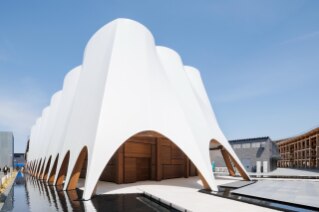The name of Tullio Vinay is rooted in the history of Riesi, a Sicilian village: here, the Waldensian shepherd founded the Christian Service Centre in the Sixties and built the Villaggio Monte degli Ulivi, that the Italian architect Leonardo Ricci designed. The village’s birth represents one of the salient experiences of the relationship between architect and pastor, which continues the adventure of Agape’s ecumenical center, in Piedmont, in the 1940s.
In the presentation of the Sicilian center project on the pages of Domus n.409, December 1963, Ricci wrote, “sometimes in desire and dream, I have seen this village expand throughout Sicily. That is, to put branches, leaves. I saw Sicily no longer as depressed, but as prosperous as it could be” – he continued – “I saw myself finally satisfied as an architect, at the service of something true to which I believe, where I see myself not as a dictator of fools, nor as a servant of the rich.”

This year, Ricci’s words come to life again in Riesi, during the first edition of the Human Laboratory of Territorial Regeneration, or more simply LURT. The project of the Waldensian Christian Service and the cultural association plug_in was inaugurated near the town center, with a workshop that saw the initial phase of the redevelopment of a property confiscated to Cosa Nostra. In fact, Ricci’s village stands on the village’s outskirts and, the inhabitants tell us, has always been seen as a civic stronghold, an opposition to Mafia’s presence on the territory. Sending your children to primary schools in the village of Vinay and Ricci was already a choice of camp: today, those schools are still in operation and continue to play that same role in the territory. During the LURT, the village was the base where conferences, dialogues, and screenings took place, and were open to citizens too. The 21 participants in the workshop then migrated daily towards the Riesi center, where the construction was proceeding.

The confiscated property’s recovery was carried out through a self-construction process led by the Roman collective Orizzontale and the Sicilian architect Flora La Sita. Sixty years after the village’s construction, the Waldensian Christian Service is entrusted with a space that allows it to approach the town more directly. The works on the building started from the ground floor, where the vocational education organised by Gianluca Fiusco’s team, director of the Servizio Cristiano Valdese in Riesi, will be concentrated. With this action, the organizers will be able to approach adolescents in particular, a difficult age group in a socially complex context, tracing a continuity with the education offered in Ricci’s village schools.
The intervention was not limited to the interiors: the opening of opaque surfaces of the house through multiple glass surfaces was followed by intervention on the street. The games that the neighborhood children play – such as four cantons, basketball, and five-a-side football – are all intertwined in a single drawing, in white, on the blue-painted asphalt. When the construction site was still in progress, the children were already playing on the road closed to traffic.
The simultaneous presence of architects, students, residents, children, and local professionals has made the construction site evocative: the formation of what is immaterial, namely the social interactions, has started thanks to the material construction on the site. The building site’s double meaning is the first gesture to approach the community, which participates in constructing its future monuments.

Ethimo's latest collection is all about weaves
Inspired by the traditional craftsmanship of Eastern Spain and patios, the new collection designed by Studio Zanellato/Bortotto reimagines the aesthetics of comfort.





















































